Leadership Styles Adaptation for Managing the Millennial Generation
VerifiedAdded on 2023/06/10
|8
|1811
|441
Essay
AI Summary
This essay examines various leadership styles and their effectiveness in managing the millennial generation workforce. It delves into relevant leadership theories such as the Great Man Theory, Trait Theory, and Behavioral Theory, analyzing how these styles impact employee engagement and organizational success. The essay highlights the millennial preference for collaborative and participative leadership approaches, emphasizing the importance of communication, empowerment, and valuing employee input. It concludes by recommending a balanced approach to leadership, tailored to specific circumstances and employee needs, while also stressing the significance of continuous development of leadership capabilities and effective conflict management. Desklib provides a platform to access this and many other solved assignments.
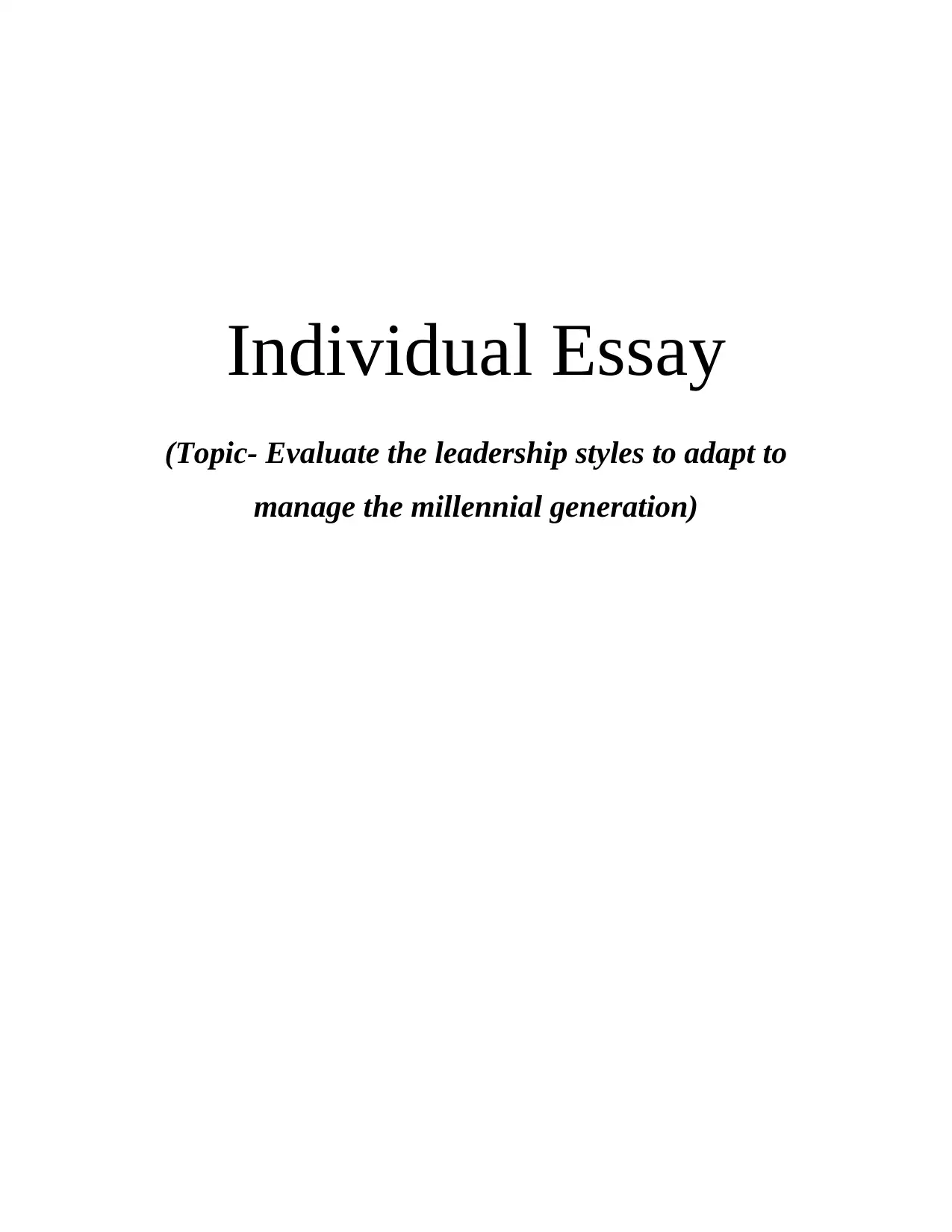
Individual Essay
(Topic- Evaluate the leadership styles to adapt to
manage the millennial generation)
(Topic- Evaluate the leadership styles to adapt to
manage the millennial generation)
Paraphrase This Document
Need a fresh take? Get an instant paraphrase of this document with our AI Paraphraser
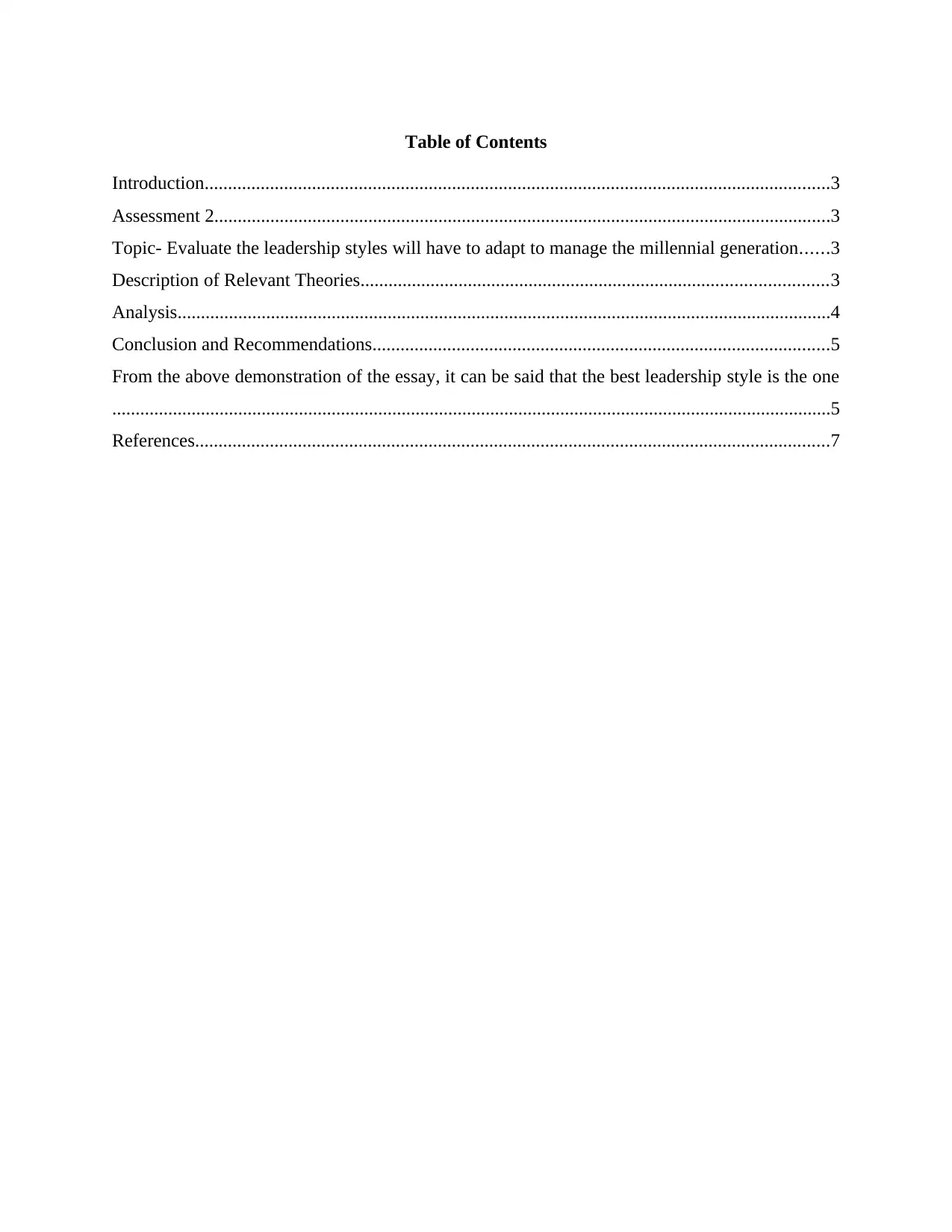
Table of Contents
Introduction......................................................................................................................................3
Assessment 2....................................................................................................................................3
Topic- Evaluate the leadership styles will have to adapt to manage the millennial generation......3
Description of Relevant Theories....................................................................................................3
Analysis............................................................................................................................................4
Conclusion and Recommendations..................................................................................................5
From the above demonstration of the essay, it can be said that the best leadership style is the one
..........................................................................................................................................................5
References........................................................................................................................................7
Introduction......................................................................................................................................3
Assessment 2....................................................................................................................................3
Topic- Evaluate the leadership styles will have to adapt to manage the millennial generation......3
Description of Relevant Theories....................................................................................................3
Analysis............................................................................................................................................4
Conclusion and Recommendations..................................................................................................5
From the above demonstration of the essay, it can be said that the best leadership style is the one
..........................................................................................................................................................5
References........................................................................................................................................7
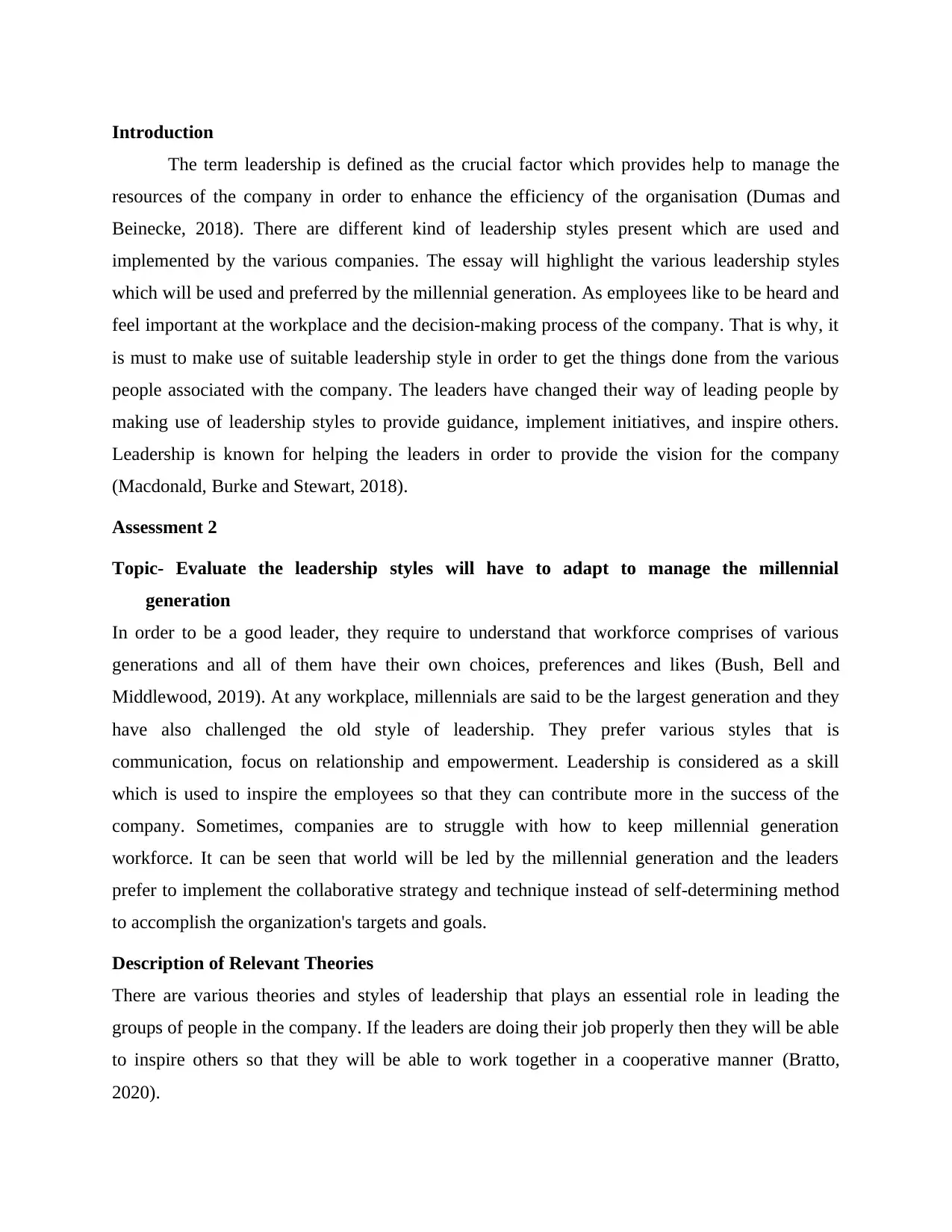
Introduction
The term leadership is defined as the crucial factor which provides help to manage the
resources of the company in order to enhance the efficiency of the organisation (Dumas and
Beinecke, 2018). There are different kind of leadership styles present which are used and
implemented by the various companies. The essay will highlight the various leadership styles
which will be used and preferred by the millennial generation. As employees like to be heard and
feel important at the workplace and the decision-making process of the company. That is why, it
is must to make use of suitable leadership style in order to get the things done from the various
people associated with the company. The leaders have changed their way of leading people by
making use of leadership styles to provide guidance, implement initiatives, and inspire others.
Leadership is known for helping the leaders in order to provide the vision for the company
(Macdonald, Burke and Stewart, 2018).
Assessment 2
Topic- Evaluate the leadership styles will have to adapt to manage the millennial
generation
In order to be a good leader, they require to understand that workforce comprises of various
generations and all of them have their own choices, preferences and likes (Bush, Bell and
Middlewood, 2019). At any workplace, millennials are said to be the largest generation and they
have also challenged the old style of leadership. They prefer various styles that is
communication, focus on relationship and empowerment. Leadership is considered as a skill
which is used to inspire the employees so that they can contribute more in the success of the
company. Sometimes, companies are to struggle with how to keep millennial generation
workforce. It can be seen that world will be led by the millennial generation and the leaders
prefer to implement the collaborative strategy and technique instead of self-determining method
to accomplish the organization's targets and goals.
Description of Relevant Theories
There are various theories and styles of leadership that plays an essential role in leading the
groups of people in the company. If the leaders are doing their job properly then they will be able
to inspire others so that they will be able to work together in a cooperative manner (Bratto,
2020).
The term leadership is defined as the crucial factor which provides help to manage the
resources of the company in order to enhance the efficiency of the organisation (Dumas and
Beinecke, 2018). There are different kind of leadership styles present which are used and
implemented by the various companies. The essay will highlight the various leadership styles
which will be used and preferred by the millennial generation. As employees like to be heard and
feel important at the workplace and the decision-making process of the company. That is why, it
is must to make use of suitable leadership style in order to get the things done from the various
people associated with the company. The leaders have changed their way of leading people by
making use of leadership styles to provide guidance, implement initiatives, and inspire others.
Leadership is known for helping the leaders in order to provide the vision for the company
(Macdonald, Burke and Stewart, 2018).
Assessment 2
Topic- Evaluate the leadership styles will have to adapt to manage the millennial
generation
In order to be a good leader, they require to understand that workforce comprises of various
generations and all of them have their own choices, preferences and likes (Bush, Bell and
Middlewood, 2019). At any workplace, millennials are said to be the largest generation and they
have also challenged the old style of leadership. They prefer various styles that is
communication, focus on relationship and empowerment. Leadership is considered as a skill
which is used to inspire the employees so that they can contribute more in the success of the
company. Sometimes, companies are to struggle with how to keep millennial generation
workforce. It can be seen that world will be led by the millennial generation and the leaders
prefer to implement the collaborative strategy and technique instead of self-determining method
to accomplish the organization's targets and goals.
Description of Relevant Theories
There are various theories and styles of leadership that plays an essential role in leading the
groups of people in the company. If the leaders are doing their job properly then they will be able
to inspire others so that they will be able to work together in a cooperative manner (Bratto,
2020).
⊘ This is a preview!⊘
Do you want full access?
Subscribe today to unlock all pages.

Trusted by 1+ million students worldwide

The great man theory
This theory was established in the nineteenth century by Thomas Carlyle Under this theory it
states that excellent leaders aren't born not developed and it also suggests that leadership is
considered as an inherent quality (Kahai and Avolio, 2020). Under this the leaders must have
various skills that is courage, charm, confidence, intelligence and many others. It is mainly based
on two assumptions that is Great leaders can arise when the need for them is important and great
leaders are born having certain traits that enable them to lead and rise (Goodwin, 2019).
The Trait theory
Under this there are certain natural qualities which are required to be a good leader such as
communication skills, strong leadership skills, being a good listener and many others (Oc, 2018).
It is also based on the features of many leaders that comprises of successful and unsuccessful
leaders. It is one of the pleasing theories and it helps in providing the detailed knowledge of the
leader's element in the whole process of leadership. It can be seen that successful leaders have
various interests and abilities (Hallinger, 2018).
The behavioural theory
It mainly targets on the ways in which the leaders behave and also the qualities can be copied
by various leaders. It comprises of various benefits such as it considers the action and reactions
of the leaders in various circumstances. It is based on valuing the leadership styles which are
related to collaboration and people. It also allows the management of the company in managing
the behaviour of the team. Such behaviour also affects the relationship with the team which will
lead to promote commitment and major contribution in the goals of the company. This theory is
based on the belief's, values and interpersonal skills of the leaders (Rosenbach, 2018).
Analysis
To achieve the organization's goals and obligations, millennial leaders prefer to use a
collaborative strategy rather than a self-determination approach. Before making important
decisions, millennial leaders will consult their teams (Guthrie and Jenkins, 2018). As a result,
organisations managed by millennials are being pushed to encourage high levels of participative
leadership in the workplace. They place a strong focus on the social aspects of professional
involvement. Employees want to be heard and want to be involved in the decision-making
process. It can also be seen that the employment market is incredibly competitive, and
millennials have realised that they must be imaginative, flexible, and original in order to benefit
This theory was established in the nineteenth century by Thomas Carlyle Under this theory it
states that excellent leaders aren't born not developed and it also suggests that leadership is
considered as an inherent quality (Kahai and Avolio, 2020). Under this the leaders must have
various skills that is courage, charm, confidence, intelligence and many others. It is mainly based
on two assumptions that is Great leaders can arise when the need for them is important and great
leaders are born having certain traits that enable them to lead and rise (Goodwin, 2019).
The Trait theory
Under this there are certain natural qualities which are required to be a good leader such as
communication skills, strong leadership skills, being a good listener and many others (Oc, 2018).
It is also based on the features of many leaders that comprises of successful and unsuccessful
leaders. It is one of the pleasing theories and it helps in providing the detailed knowledge of the
leader's element in the whole process of leadership. It can be seen that successful leaders have
various interests and abilities (Hallinger, 2018).
The behavioural theory
It mainly targets on the ways in which the leaders behave and also the qualities can be copied
by various leaders. It comprises of various benefits such as it considers the action and reactions
of the leaders in various circumstances. It is based on valuing the leadership styles which are
related to collaboration and people. It also allows the management of the company in managing
the behaviour of the team. Such behaviour also affects the relationship with the team which will
lead to promote commitment and major contribution in the goals of the company. This theory is
based on the belief's, values and interpersonal skills of the leaders (Rosenbach, 2018).
Analysis
To achieve the organization's goals and obligations, millennial leaders prefer to use a
collaborative strategy rather than a self-determination approach. Before making important
decisions, millennial leaders will consult their teams (Guthrie and Jenkins, 2018). As a result,
organisations managed by millennials are being pushed to encourage high levels of participative
leadership in the workplace. They place a strong focus on the social aspects of professional
involvement. Employees want to be heard and want to be involved in the decision-making
process. It can also be seen that the employment market is incredibly competitive, and
millennials have realised that they must be imaginative, flexible, and original in order to benefit
Paraphrase This Document
Need a fresh take? Get an instant paraphrase of this document with our AI Paraphraser
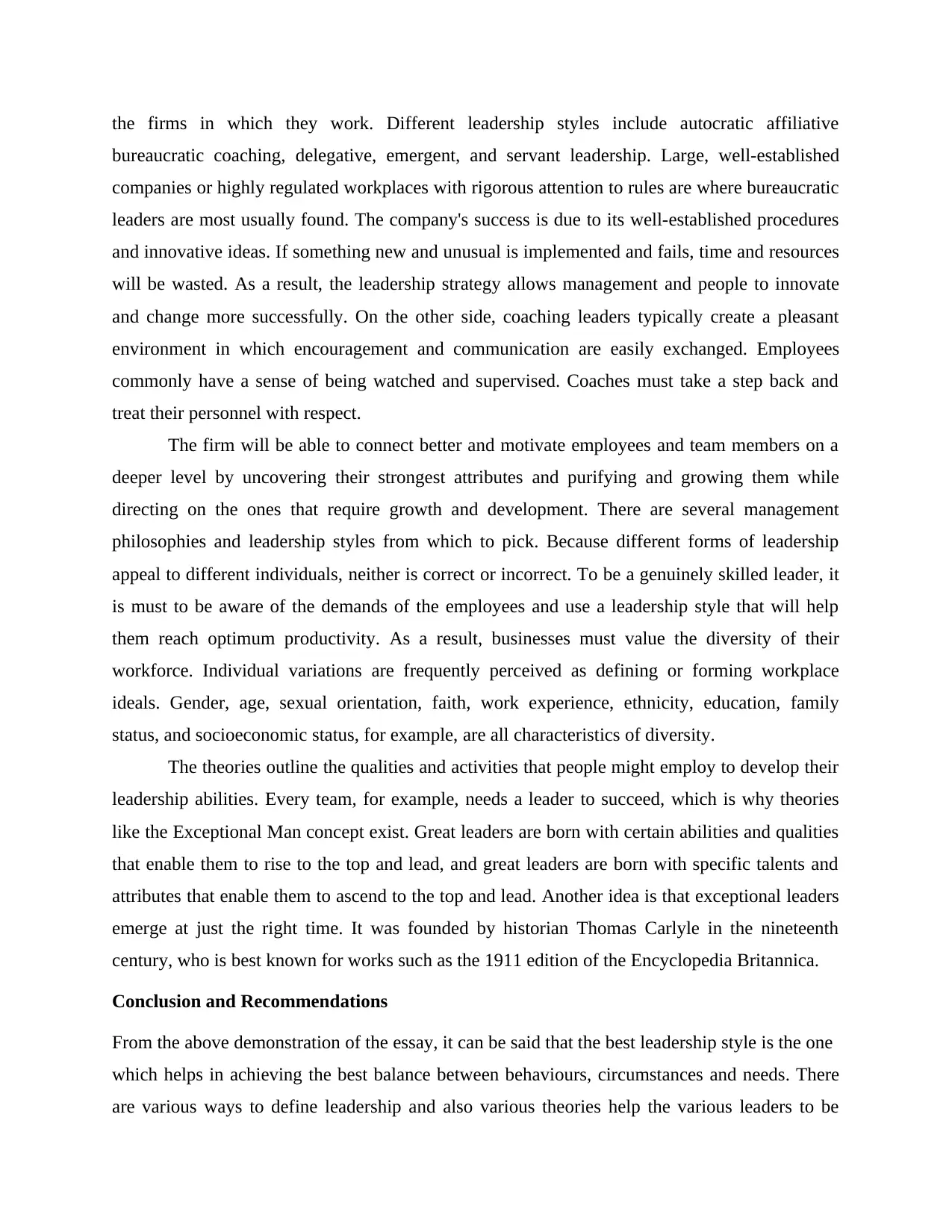
the firms in which they work. Different leadership styles include autocratic affiliative
bureaucratic coaching, delegative, emergent, and servant leadership. Large, well-established
companies or highly regulated workplaces with rigorous attention to rules are where bureaucratic
leaders are most usually found. The company's success is due to its well-established procedures
and innovative ideas. If something new and unusual is implemented and fails, time and resources
will be wasted. As a result, the leadership strategy allows management and people to innovate
and change more successfully. On the other side, coaching leaders typically create a pleasant
environment in which encouragement and communication are easily exchanged. Employees
commonly have a sense of being watched and supervised. Coaches must take a step back and
treat their personnel with respect.
The firm will be able to connect better and motivate employees and team members on a
deeper level by uncovering their strongest attributes and purifying and growing them while
directing on the ones that require growth and development. There are several management
philosophies and leadership styles from which to pick. Because different forms of leadership
appeal to different individuals, neither is correct or incorrect. To be a genuinely skilled leader, it
is must to be aware of the demands of the employees and use a leadership style that will help
them reach optimum productivity. As a result, businesses must value the diversity of their
workforce. Individual variations are frequently perceived as defining or forming workplace
ideals. Gender, age, sexual orientation, faith, work experience, ethnicity, education, family
status, and socioeconomic status, for example, are all characteristics of diversity.
The theories outline the qualities and activities that people might employ to develop their
leadership abilities. Every team, for example, needs a leader to succeed, which is why theories
like the Exceptional Man concept exist. Great leaders are born with certain abilities and qualities
that enable them to rise to the top and lead, and great leaders are born with specific talents and
attributes that enable them to ascend to the top and lead. Another idea is that exceptional leaders
emerge at just the right time. It was founded by historian Thomas Carlyle in the nineteenth
century, who is best known for works such as the 1911 edition of the Encyclopedia Britannica.
Conclusion and Recommendations
From the above demonstration of the essay, it can be said that the best leadership style is the one
which helps in achieving the best balance between behaviours, circumstances and needs. There
are various ways to define leadership and also various theories help the various leaders to be
bureaucratic coaching, delegative, emergent, and servant leadership. Large, well-established
companies or highly regulated workplaces with rigorous attention to rules are where bureaucratic
leaders are most usually found. The company's success is due to its well-established procedures
and innovative ideas. If something new and unusual is implemented and fails, time and resources
will be wasted. As a result, the leadership strategy allows management and people to innovate
and change more successfully. On the other side, coaching leaders typically create a pleasant
environment in which encouragement and communication are easily exchanged. Employees
commonly have a sense of being watched and supervised. Coaches must take a step back and
treat their personnel with respect.
The firm will be able to connect better and motivate employees and team members on a
deeper level by uncovering their strongest attributes and purifying and growing them while
directing on the ones that require growth and development. There are several management
philosophies and leadership styles from which to pick. Because different forms of leadership
appeal to different individuals, neither is correct or incorrect. To be a genuinely skilled leader, it
is must to be aware of the demands of the employees and use a leadership style that will help
them reach optimum productivity. As a result, businesses must value the diversity of their
workforce. Individual variations are frequently perceived as defining or forming workplace
ideals. Gender, age, sexual orientation, faith, work experience, ethnicity, education, family
status, and socioeconomic status, for example, are all characteristics of diversity.
The theories outline the qualities and activities that people might employ to develop their
leadership abilities. Every team, for example, needs a leader to succeed, which is why theories
like the Exceptional Man concept exist. Great leaders are born with certain abilities and qualities
that enable them to rise to the top and lead, and great leaders are born with specific talents and
attributes that enable them to ascend to the top and lead. Another idea is that exceptional leaders
emerge at just the right time. It was founded by historian Thomas Carlyle in the nineteenth
century, who is best known for works such as the 1911 edition of the Encyclopedia Britannica.
Conclusion and Recommendations
From the above demonstration of the essay, it can be said that the best leadership style is the one
which helps in achieving the best balance between behaviours, circumstances and needs. There
are various ways to define leadership and also various theories help the various leaders to be
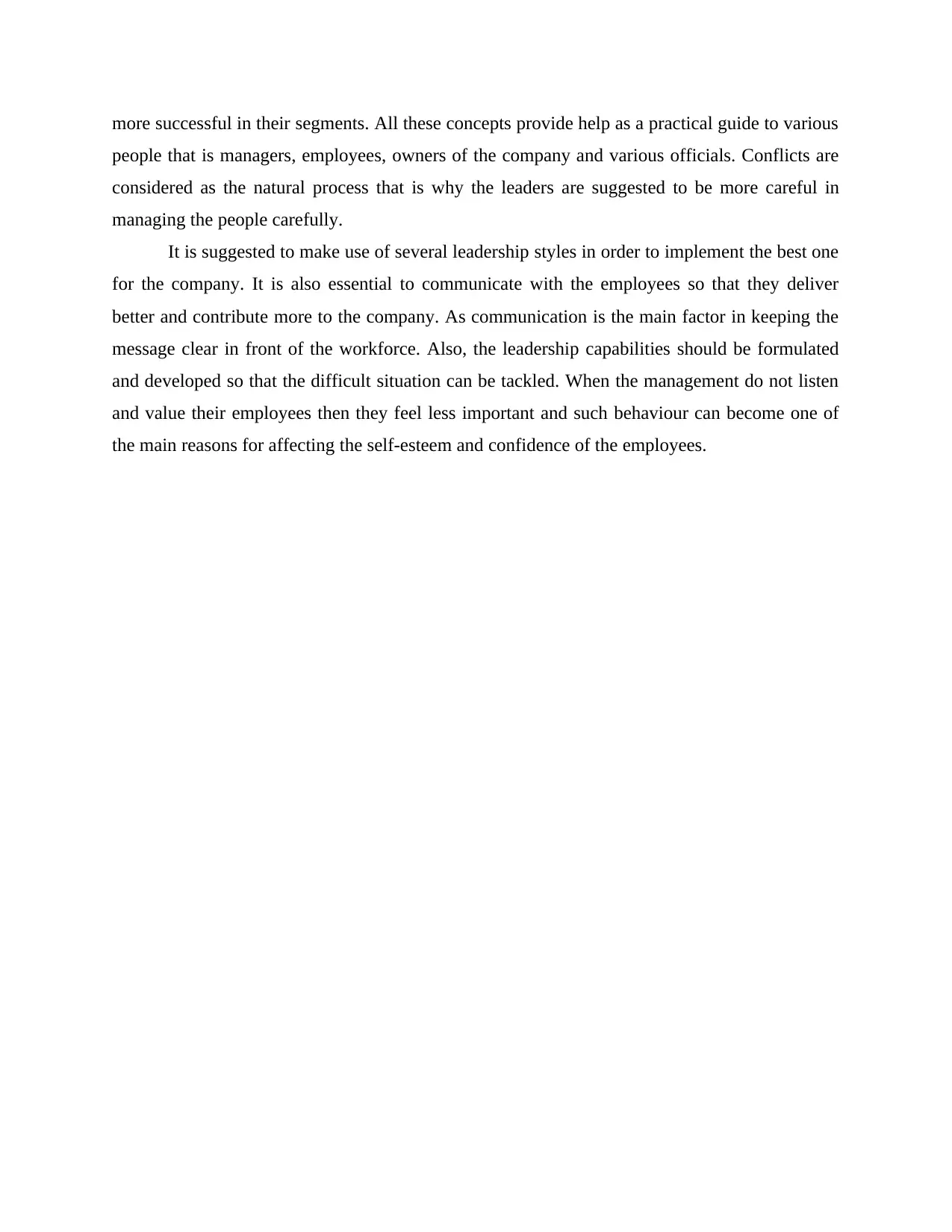
more successful in their segments. All these concepts provide help as a practical guide to various
people that is managers, employees, owners of the company and various officials. Conflicts are
considered as the natural process that is why the leaders are suggested to be more careful in
managing the people carefully.
It is suggested to make use of several leadership styles in order to implement the best one
for the company. It is also essential to communicate with the employees so that they deliver
better and contribute more to the company. As communication is the main factor in keeping the
message clear in front of the workforce. Also, the leadership capabilities should be formulated
and developed so that the difficult situation can be tackled. When the management do not listen
and value their employees then they feel less important and such behaviour can become one of
the main reasons for affecting the self-esteem and confidence of the employees.
people that is managers, employees, owners of the company and various officials. Conflicts are
considered as the natural process that is why the leaders are suggested to be more careful in
managing the people carefully.
It is suggested to make use of several leadership styles in order to implement the best one
for the company. It is also essential to communicate with the employees so that they deliver
better and contribute more to the company. As communication is the main factor in keeping the
message clear in front of the workforce. Also, the leadership capabilities should be formulated
and developed so that the difficult situation can be tackled. When the management do not listen
and value their employees then they feel less important and such behaviour can become one of
the main reasons for affecting the self-esteem and confidence of the employees.
⊘ This is a preview!⊘
Do you want full access?
Subscribe today to unlock all pages.

Trusted by 1+ million students worldwide
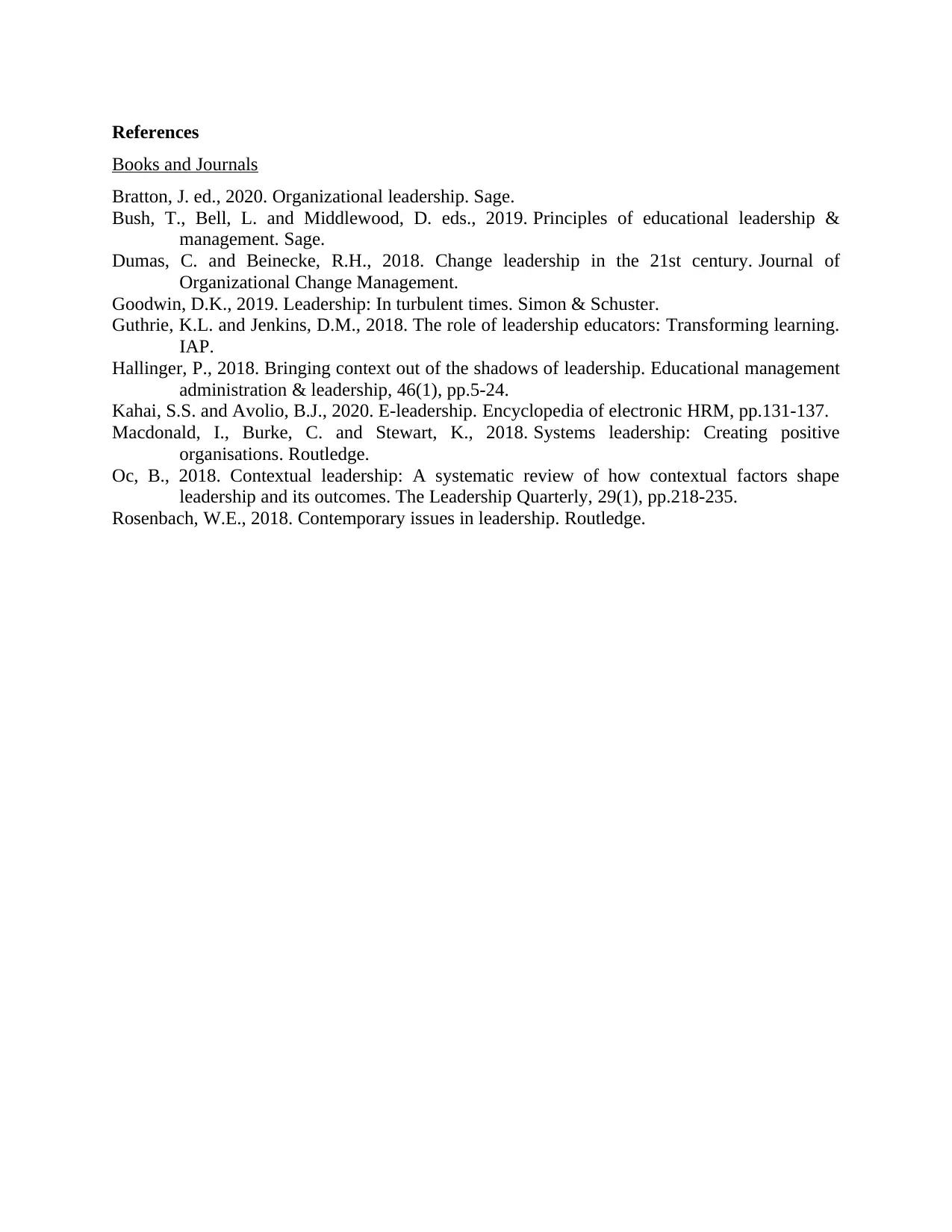
References
Books and Journals
Bratton, J. ed., 2020. Organizational leadership. Sage.
Bush, T., Bell, L. and Middlewood, D. eds., 2019. Principles of educational leadership &
management. Sage.
Dumas, C. and Beinecke, R.H., 2018. Change leadership in the 21st century. Journal of
Organizational Change Management.
Goodwin, D.K., 2019. Leadership: In turbulent times. Simon & Schuster.
Guthrie, K.L. and Jenkins, D.M., 2018. The role of leadership educators: Transforming learning.
IAP.
Hallinger, P., 2018. Bringing context out of the shadows of leadership. Educational management
administration & leadership, 46(1), pp.5-24.
Kahai, S.S. and Avolio, B.J., 2020. E-leadership. Encyclopedia of electronic HRM, pp.131-137.
Macdonald, I., Burke, C. and Stewart, K., 2018. Systems leadership: Creating positive
organisations. Routledge.
Oc, B., 2018. Contextual leadership: A systematic review of how contextual factors shape
leadership and its outcomes. The Leadership Quarterly, 29(1), pp.218-235.
Rosenbach, W.E., 2018. Contemporary issues in leadership. Routledge.
Books and Journals
Bratton, J. ed., 2020. Organizational leadership. Sage.
Bush, T., Bell, L. and Middlewood, D. eds., 2019. Principles of educational leadership &
management. Sage.
Dumas, C. and Beinecke, R.H., 2018. Change leadership in the 21st century. Journal of
Organizational Change Management.
Goodwin, D.K., 2019. Leadership: In turbulent times. Simon & Schuster.
Guthrie, K.L. and Jenkins, D.M., 2018. The role of leadership educators: Transforming learning.
IAP.
Hallinger, P., 2018. Bringing context out of the shadows of leadership. Educational management
administration & leadership, 46(1), pp.5-24.
Kahai, S.S. and Avolio, B.J., 2020. E-leadership. Encyclopedia of electronic HRM, pp.131-137.
Macdonald, I., Burke, C. and Stewart, K., 2018. Systems leadership: Creating positive
organisations. Routledge.
Oc, B., 2018. Contextual leadership: A systematic review of how contextual factors shape
leadership and its outcomes. The Leadership Quarterly, 29(1), pp.218-235.
Rosenbach, W.E., 2018. Contemporary issues in leadership. Routledge.
Paraphrase This Document
Need a fresh take? Get an instant paraphrase of this document with our AI Paraphraser

1 out of 8